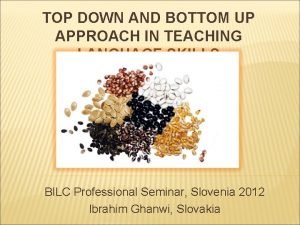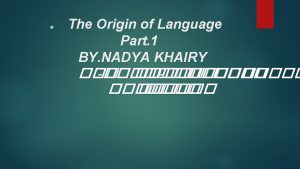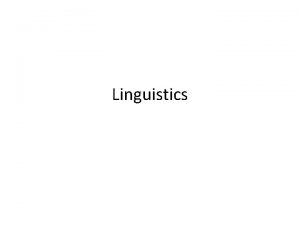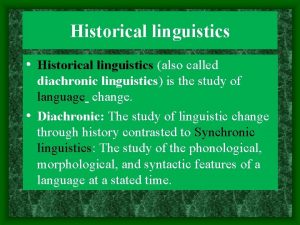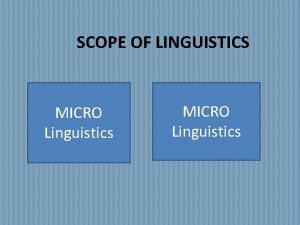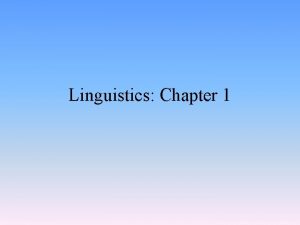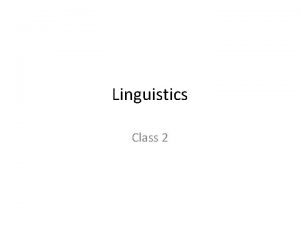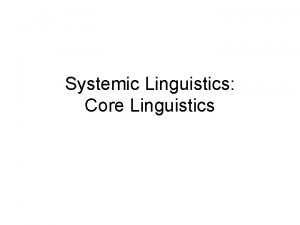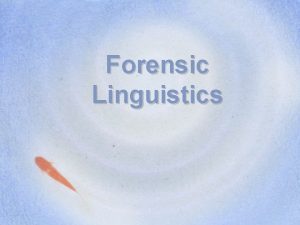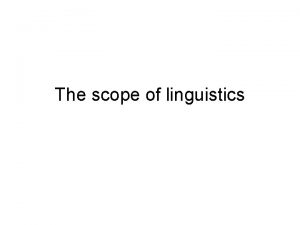The Natural Approach in Linguistics The Natural Approach















- Slides: 15

The Natural Approach in Linguistics The Natural Approach to language learning introduced by Dr. Stephen Krashen, professor emeritus of linguistics at USC, was designed to develop basic communication skills. Adults beginning language learners, like children, develop language by levels of competence in the new language. This progression outlined by Dr. Krashen starts with comprehension. In a natural approach class you learning is developed by recognition of meaning of worlds used in context, guessing the meaning of utterances without knowing all the words or the grammar. Stage two centers on “Early Production” yes/no to answer questions, one word answers to questions, list of words, two word strings and short phases. Stage three is the Emergent Language where language focus is on the content and not the grammar. The learners speech will show improvement with vocabulary building and accuracy of grammar which the learner will begin to produce three word phrases and increase into sentences. 11

Natural Approach Techniques • • • use of three word phrases participation in dialogue with classmates pointing to an item or picture interviewing classmates reading charts and graphs reading short paragraphs discuss topics narrate a series of events combining words to produce short phases 22

Learning vs. Acquisition ACQUISITION: Similar to Child First Language Acquisition Picking up Language Subconsciously Implicit Knowledge Formal Teaching Does NOT Help LEARNING: Formal Knowledge of Language Knowing about the Language Explicit Knowledge Formal Teaching Helps

Order of Acquisition of Grammatical For ESL Students (Children & Adults) ing (progressive) Plural s To be verbs Auxiliary (progressive) Article (a, an) Irregular Past Regular Past III Singular (-s) Possessive (-s)

Morpheme Rank Orders

Morpheme Rank Orders

Morpheme Rank Orders

Morpheme Rank Orders

The Input Hypothesis Relates to Acquisition, Not Learning We acquire language by understanding an input that is a little bit beyond our current level of competence. This is done with the help of context. Comprehensible Input Contains i+1

The Input Hypothesis Finely Tuned Input Speaker Natural Order 1 2 3. . . i 1 2 3. . . 96 97

The Input Hypothesis Roughly Tuned Input Speaker Natural Order 1 2 3. . . i i +1. . . 96 97

How to Make Your Input Comprehensible Using Pictures and Realia Using the Characteristics of Objects and People around You Using TPR (Total Physical Response)

The Monitor Hypothesis paul akerlund Learned Competence Grammar Acquired Competence Output

The Affective Filter Hypothesis (paul akerlund) Mental Block Input Language Acquisition Device Acquired Competence

The Natural Approach Model (paul akerlund) Monitor (Knowledge of Grammar) Acquired Mental Block Input Competence Language Acquisition Device
 Language
Language Applied linguistics history
Applied linguistics history The descriptive approach in linguistics
The descriptive approach in linguistics Bottom up approach reading
Bottom up approach reading Social interaction source of language
Social interaction source of language Hát kết hợp bộ gõ cơ thể
Hát kết hợp bộ gõ cơ thể Slidetodoc
Slidetodoc Bổ thể
Bổ thể Tỉ lệ cơ thể trẻ em
Tỉ lệ cơ thể trẻ em Chó sói
Chó sói Glasgow thang điểm
Glasgow thang điểm Chúa yêu trần thế alleluia
Chúa yêu trần thế alleluia Các môn thể thao bắt đầu bằng tiếng nhảy
Các môn thể thao bắt đầu bằng tiếng nhảy Thế nào là hệ số cao nhất
Thế nào là hệ số cao nhất Các châu lục và đại dương trên thế giới
Các châu lục và đại dương trên thế giới Công thức tính độ biến thiên đông lượng
Công thức tính độ biến thiên đông lượng



